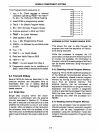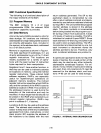
SINGLE
COMPONENT
SYSTEM
Unlike
the
8048,
in
the
8022
the
unincremented
program
counter
address
is
stored
in
the
address
stack.
The
stack
contents
are
then
incremented
before
being
loaded
Into
the
program
counter
dur-
ing
a
return
(RET)
from
subroutine.
However,
dur-
ing
a return (RETI) from interrupt, the stack
contents are
loaded
directly into the program
counter.
This
difference
makes
it imperative to
use
only
RETI's
to return
from
interrupts,
and
RET's
to
return
from
subroutines.
Since
the
program
counter's addresses
are
11
bits
long,
two bytes
or
registers
must
be
used
to
store a
single
address.
Thus,
the
16-byte
program
counter
stack
permits
up
to a total of 8
levels
of
subroutine
nesting
without
overflowing
the
stack.
If overflow does occur, the deepest address
stored
(locations
8
and
9)
will
be
overwritten
and
lost
since
the
stack
pointer
overflows
from
111
to
000.
It
also
underflows
from
000 to
111.
If
a
par-
ticular application
does
not
require
8 levels of
nesting,
the
unused
portion
of
the
progam
counter
stack
may
be
used
as
any
other indirectly
addres-
sable
RAM
location.
For
example,
if
only
3
levels
of
subroutine
nesting
are
used,
then
only
locations
8-13
need
be
reserved
for
the
program
counter
stack,
and
locations
14-23
can
be
used
for
data
storage.
18
24
23
8
LEVEL
aTACK
OR
USER
RAM
18.8
Rl~l\r:.
1
DATA
MEMORY
MAP
ADDRJ.
IN
DIRE
THROU
EIIED
CTLV
QH
RGORR
1
DIRECTlv
ADDR~8LE
2. 14 Oscillator and Clock
The
8022
contains
its
own
on-board
oscillator
and
clock circuit,
requiring
only
an
external
timing
con-
trol
element.
This
control
element
can
be
a cry-
stal,
inductor,
or
clock.
All
Internal
time
slots
are
derived
from
the
external
element,
and
all
outputs
are a
function
of
the
oscillator
frequency.·
An
in-
struction
cycle
consists
of
10
states,
and
each
state
is
a
time
slot
of
3 oscillator
periods.
There-
fore,
to
obtain
a
10
fJ,s
instruction
cycle, a 3
MHz
crystal
should
be
used.
The
minimum
instruction
cycle
time
of
8.4
fJ,sec
corresponds
to a 3.58
mHz
crystal.
'2.15 Timer/Event Counter
Like
the
other
MCS-48
microcomputers,
the
8022
has
an
internal
timer
I
event
counter.
This
circuit
can
monitor
elapsed
time
or
count
external
events
that
occur
during
program
execution.
See
the
8021
description,
Section
2.8,
for a
com-
plete
explanation.
The
8022
has
26
lines
which
can
be
used
for
digi-
tal
input
or
output
functions.
These
lines
are
orga-
nized
as
3 ports of 8
lines,
each
of
which
serve
as
either
inputs,
outputs,
or
bidirectional
ports,
and
2
test
inputs
which
can
alter
program
sequences
when
tested
by
conditional
jump
instructions.
Ports
1
and
2
have
identical
operating
character-
istics
and
are
both
quasi-bidirectional.
That
is,
each
line
may
serve
as
an
input,
an
output,
or
both.
Data
written to these ports
is
statically
latched
and
remains
unchanged
until
rewritten.
As
inputs,
these
lines
are
non-latching;
i.e.,
inputs
must
be
present
until
read
by
an
input
instruction.
Inputs
are
fully
TTL
compatible
and
all
outputs
will
drive
at
least
one
standard
TTL
load.
See
Section
2.1.4 for a
more
complete
description
of
the
qua-
si-bidirectional
structure.
2.16.1 Port 0 Comparator Inputs
Port
0
has
been
modified
from
the
standard
quasi-
bidirectional
structure
to
allow
an
optional
open
drain
configuration
with
comparator
inputs.
The
low
impedance
pullup
device
has
been
eliminated
and
the
high
impedance
pullup
is
optional.
Thus,
the
user
can
choose
via
a
mask
programmable
selection
each
line
of
port a to
be
either
quasi-bi-
directional
with
a
high
impedance
or
true
open-
drain.
The
open
drain
configuration
allows
the
line
to
sink
current
through
the
low
impedance
pull-
down
device
or
to
float
in
the
high
output
state.
More
importantly,
the
open
drain
configuration
makes
port 0
very
easy
to
drive
when
it
is
used
as
inputs.
The
input
circuitry for
each
line
of
port 0
includes
a
voltage
comparator
which
amplifies
the
voltage
difference
between
the
input
port
line
and
the
port 0
threshold
reference
pin
(VTH).
The
volt-
age
gain
of
the
comparator
is
sufficient
to
sense
a
100
mV
input
differential
within
the
range
VSS
to
VCC
/2
.·
.
If
VTH
is
allowed
to
float,
it
will
bias
itself to
the
digital switch
point
of
the
other
ports,
and
port a
behaves
as
a set of
normal
digital
inputs.
Howev-
er,
by
biasing
VTH,
the
switch
point
can
be
both
tightly
controlled
and
adjusted.
Common
uses
for
2·26


















